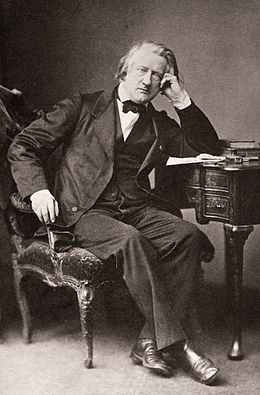Henri Victor Regnault
Henri Victor Regnault (born July 21, 1810 in Aachen , † January 19, 1878 in Auteuil ) was a French physicist and chemist .
Regnault lost his parents at the age of eight and went to Paris . He worked in a furniture factory until he was 18. From 1830 he attended the École polytechnique in Paris , which he completed in 1832 with a mining exam. He then worked in mining and then became a professor in Lyon .
Later he worked under Justus von Liebig in Giessen , where he studies on the synthesis of chlorinated hydrocarbons for organic chemistry found.
Because of his treatise L'action du chlore sur l'éther chlorhydrique , he became a member of the Academy of Sciences and Professor of Chemistry at the École Polytechnique in Paris in 1840 . The following year he received a chair in physics at the Collège de France and in 1847 became chief engineer of the mining industry. From 1843 he created tables on fluid mechanics, which he published in 1847, for which he received the Rumford Medal of the Royal Society of London .
Many of his students later became famous scientists: such as the physicist Jean Bernard Léon Foucault (1819–1868), the chemist Robert Wilhelm Bunsen (1811–1899), the botanist Georges Ville (1824–1897) or the physiologist Jules Reise (1818–1896) ) who worked for him in the Regnault laboratory at the Collège de France. At the École Polytechnique he was the mentor of the Scottish physicist William Thomson from 1845–46 .
From 1847 he was a corresponding and from 1863 a foreign member of the Prussian Academy of Sciences . In 1853 he was elected by the Bavarian Academy of Sciences as its external member, and the porcelain manufactory in Sèvres appointed Regnault as director the following year. In 1855 Regnault was elected to the American Academy of Arts and Sciences . From 1852 he was a foreign member ( Foreign Member ) of the Royal Society and from 1855 honorary member ( Honorary Fellow ) of the Royal Society of Edinburgh . In 1859 he was elected a foreign member of the Göttingen Academy of Sciences , and in 1865 of the National Academy of Sciences .
In Sèvres he also dealt with the heat states of solids and the thermodynamics of gases and vapors. He designed highly sensitive thermometers , hygrometers and calorimeters and took measurements of specific heat , heat capacity (including confirmation of the Dulong-Petit law ) and the thermal expansion of gases. He found that not all gases expand equally and that Boyl's law is only an approximation for temperatures near the boiling point .
Regnault also discovered the substances carbon tetrachloride , vinyl chloride and trichlorethylene . He was also an amateur photographer and in 1854 became the founding president of the Société Française de Photographie .
His son Alex-Georges-Henri Regnault was killed in the Franco-Prussian War in 1871 , which also destroyed his laboratory in Sèvres. He then withdrew from science.
Henri Victor Regnault died on January 19, 1878 in Auteuil.
The ideal gas constant R = 8.31441 J / (mol · K) should be named after him. His name is immortalized on the Eiffel Tower, see: The 72 names on the Eiffel Tower . The lunar crater Regnault was also named after him.
Works
- Regnault-Strecker's short textbook on chemistry . Vieweg, Braunschweig 1851 Digitized edition of the University and State Library Düsseldorf
Web links
- The Legacy of Henri Victor Regnault in the Arts and Sciences . International Journal of Arts & Sciences, 21st of July 2010
- Entry in the Catholic Encyclopedia (English)
Individual evidence
- ^ List of members since 1666: Letter R. Académie des sciences, accessed on February 20, 2020 (French).
- ^ Members of the previous academies. Henri Victor Regnault. Berlin-Brandenburg Academy of Sciences , accessed June 1, 2015 .
- ↑ Prof. Dr. Henri Victor Regnault , members of the Bavarian Academy of Sciences
- ^ Fellows Directory. Biographical Index: Former RSE Fellows 1783–2002. (PDF file) Royal Society of Edinburgh, accessed April 2, 2020 .
- ↑ Holger Krahnke: The members of the Academy of Sciences in Göttingen 1751-2001 (= Treatises of the Academy of Sciences in Göttingen, Philological-Historical Class. Volume 3, Vol. 246 = Treatises of the Academy of Sciences in Göttingen, Mathematical-Physical Class. Episode 3, vol. 50). Vandenhoeck & Ruprecht, Göttingen 2001, ISBN 3-525-82516-1 , p. 198.
| personal data | |
|---|---|
| SURNAME | Regnault, Henri Victor |
| BRIEF DESCRIPTION | French physicist and chemist |
| DATE OF BIRTH | July 21, 1810 |
| PLACE OF BIRTH | Aachen |
| DATE OF DEATH | January 19, 1878 |
| Place of death | Auteuil |
